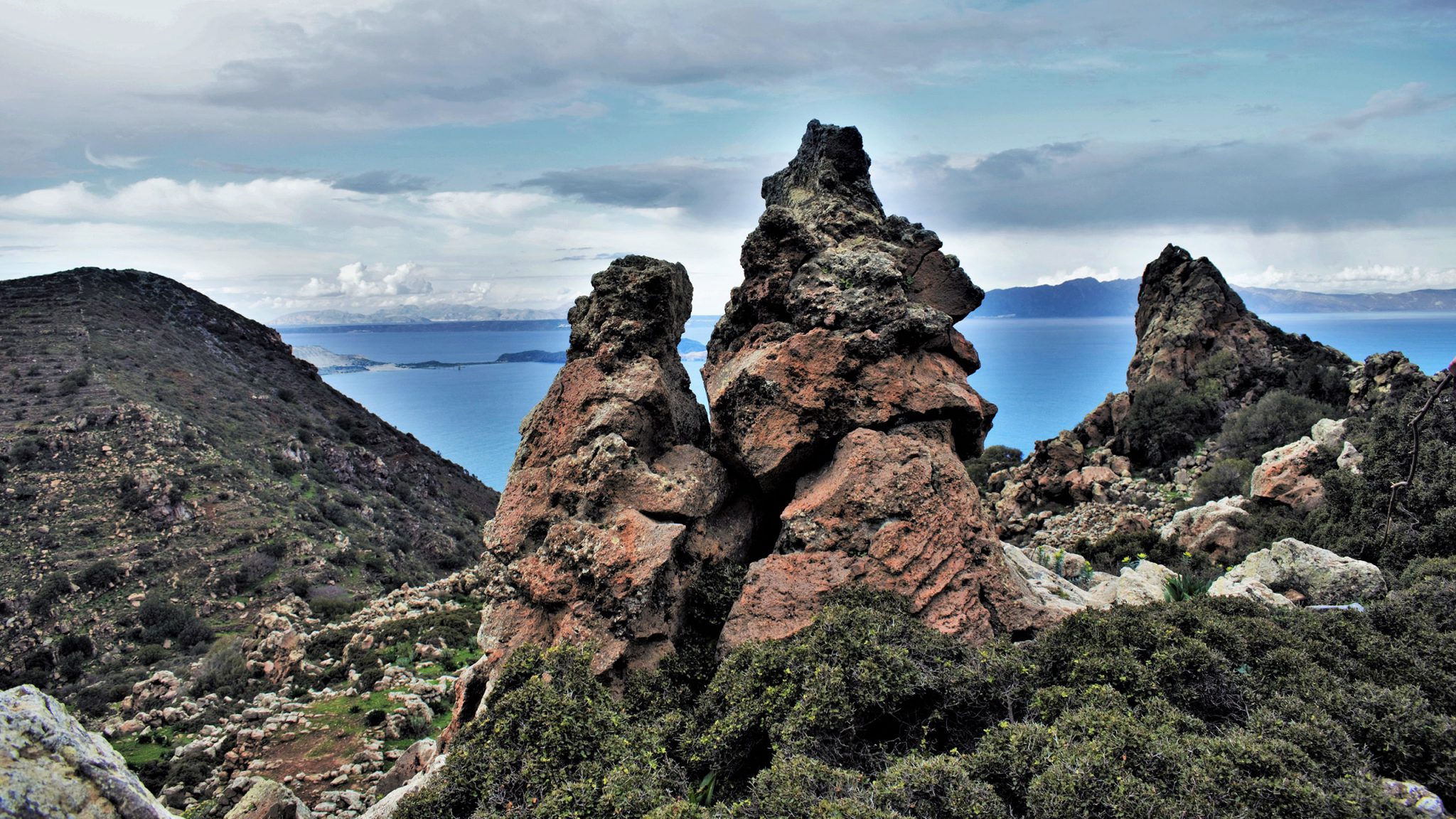
This is perhaps the most interesting trail, leading to the highest peak of Nisyros (altitude 698 m). Start very early and well-prepared for the climb. There is a paved road up to the Monastery of Evangelistria. The climb starts from the Monastery of Evangelistria, and the time to reach the summit is approximately one hour of normal walking without stops. Initially, you will walk a few minutes on the path that moves along the northwest slopes of the caldera, where you will observe andesite lava flows and scoria of the intermediate andesitic lavas (Site 2.1).
Once you reach the point where the lavas of the Prophet Elias dome meet the caldera, turn left and begin the ascent over the dacites of the most recent volcanic eruptions, which formed the post-caldera domes (Site 2.2). Observe the rocks carefully. Inside the tephra dacites, you will see many rounded pieces of a darker purple rock. This is an andesite that intruded into the dacitic magma chamber and together made their way to the surface. The trail is clear and passable in the first part, but be cautious not to lose it between 450–500 meters. Sixty meters below the summit, after crossing the oak forest covering the northwestern slope of the dome, at an altitude of 638 meters, you will find the "hanging garden" of Diavatis (Site 2.3). An oasis of tall trees – walnut, fig, pear, etc. – in a flat circular area surrounded by a high stone wall. This circular structure is a withdrawal crater of the Prophet Elias dome, a common structure in domes, created during the final phase of the eruption due to the contraction of magma during cooling and withdrawal into the exit conduit. At the entrance to Diavatis stands a white house, with a date engraved in the lava of its cistern: 1749. The church behind the house is of Panagia Diavatiani (Milk-Giving), with impressive frescoes possibly from the 17th century. Opposite the church are small cells, in poor condition, that once housed the nuns of the monastery. Continue along the path and take the left route to the easternmost point where you will enjoy the view of all southwestern Nisyros, particularly the caldera and the hydrothermal craters (Site 2.4).
Continue westward and in a few minutes, you will reach the summit of Prophet Elias with its requisite small chapel, 698 meters above sea level (Site 2.5). The view from here is unique to the west. Those who can handle the walk can proceed south of Prophet Elias and admire the complex of Saint Panteleimon in the saddle before the dome of Trapenzina (Site 2.6). The return is recommended via the impressive Nyphios plateau. In the first part of the trail, you will admire the "spikes" of the dome's lavas to your left (Site 2.7). On the Nyphios plateau are the only signs of Minoan presence on Nisyros: a summit sanctuary with double horns of consecration at the northern entrance of the plateau (Site 2.8) and traces of habitation (Site 2.9). In classical antiquity, this became a sanctuary of the Nymphs (hence the place name Nyphios), located in a carved cave that is now the church of Saint John of Kalyvitis (Site 2.10). In the northern part, there is a monastic complex dedicated to the Bridegroom Christ (Site 2.11). In the saddle between the domes of Prophet Elias and the Visternias, you can observe points of warm steam emission – especially on the northern sides. The eastern edge of the saddle is another viewpoint of the caldera and the hydrothermal craters. The return from Nyphios can be made via a 30-minute downhill trail either to Evangelistria or Lakki. At the intersection, the fronts of lava flows fed by the Boraiatiko dome dominate (Site 2.12).
Descending the trail, you will observe andesitic lava flows on the northern slopes of the caldera and at the base rises a characteristic neck of andesitic lava, above the small plain, Lower Lakki, what remains of the northern part of the caldera floor (Site 2.13). At Evangelistria, make a short stop at the monastery and enjoy the cool breeze under the branches of the giant oleander in its courtyard.

